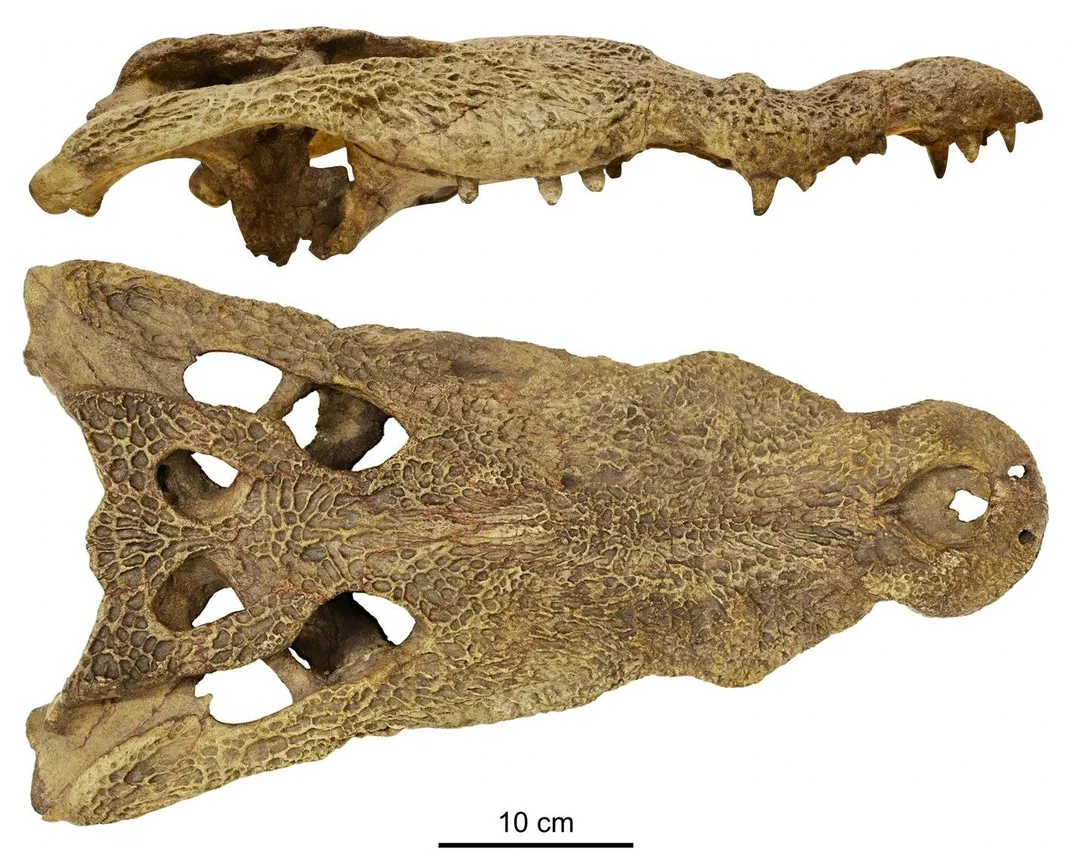New Evidence Suggests Ancient Crocodiles Swam From Africa to America
The prehistoric reptiles would have gotten some help from ocean currents
/https://tf-cmsv2-smithsonianmag-media.s3.amazonaws.com/filer/0a/6c/0a6c9886-3d45-4087-926d-088bce2dc857/2020_july26_bigcroc.png)
Most American crocodiles don’t need to look far to find the feature that sets them apart from Nile crocodiles. The difference lies right between their eyes and their nostrils. Of crocodiles living today, only the four crocodile species that live in the Americas have a small bump in the middle of their snouts.
But about seven million years ago, a ten-foot-long crocodile living in what’s now Libya had the same tell-tale lump, according to research published in Scientific Reports last week. A fossil skull of the extinct Crocodylus checchiai provides more evidence that crocodiles spread across the world by migrating from Australia, through Africa and finally to South America.
The fossil “fills a gap between the Nile crocodile in Africa and the four extant American species,” University of Turin paleoherpetologist Massimo Delfino says to Science News’ Carolyn Wilke.
The fact that crocodiles live on both sides of the Atlantic Ocean has long puzzled biologists trying to figure out which direction the giant reptiles migrated. Genetic research in 2011 provided molecular evidence that crocodiles migrated from Africa to the Americas, but fossil evidence was scant.
"The main problem for palaeobiologists is the rarity and fragmentary nature of fossil remains,” Delfino and co-author David Iurino told the Agence France-Presse by email.

The fossil described in the new paper is one of four that were first described in the 1930s. Three that were stored in the Natural History Museum in Tripoli, Libya, were lost or destroyed during World War II, according to the Scientific Reports paper. But the researchers found the fourth skull, originally collected in 1939, stored in the Sapienza University of Rome.
"This fossil is twice-old," Delfino tells Nina Pullano at Inverse, referencing the fact that the skull is millions of years old and had then been forgotten for decades. The researchers used CT scanning to create a 3D model of the inside and outside of the skull for closer study and confirmed the presence of the American crocodile-like snout bump.
At seven million years old, the C. checchiai skull predates all known crocodile fossils in America, the oldest of which are about five million years old, Lucy Hicks reports for Science magazine. That means that the timeline checks out: it’s possible that C. checchiai may have made their way from Libya to the western coast of Africa, swam across the Atlantic and landed on the shores of South America.
The continents were about the same distance apart seven million years ago as they are today, making the journey across the ocean quite a feat—but not impossible. The researchers point out in a statement that the Australian marine crocodile has been recorded travelling more than 300 miles in a day. The prehistoric croc may have also bobbed along on one of the ocean’s surface currents that travel west from Africa to the Americas.
Crocodiles are also not the only flightless animal thought to have reached the New World by crossing the Atlantic. As the Inverse reports, a study published in April suggests that on two instances, monkeys made their way across the ocean on floating vegetation.
"If you think that the monkey can cross the Atlantic Ocean, very probably it's much easier to accept that the crocodile can do it," Delfino tells Inverse. Ancient crocodiles had the specialized glands necessary to swim and survive in saltwater and may have snacked on sea turtles along the way.
As a changing climate wiped out local species, crocodiles were well adapted to the late-Miocene environment and replaced them, the researchers write in the paper. The original crew of ocean-crossing crocs may have included many individuals or at least one pregnant female, Science News reports.
And after situating themselves in South America, they evolved and diversified into the four species found in the Americas today. (Only the American crocodile and American alligator are found in the United States.)
But whether or not the crocodilians mourn their C. checchiai ancestors is hard to tell—they might just be crocodile tears, after all.